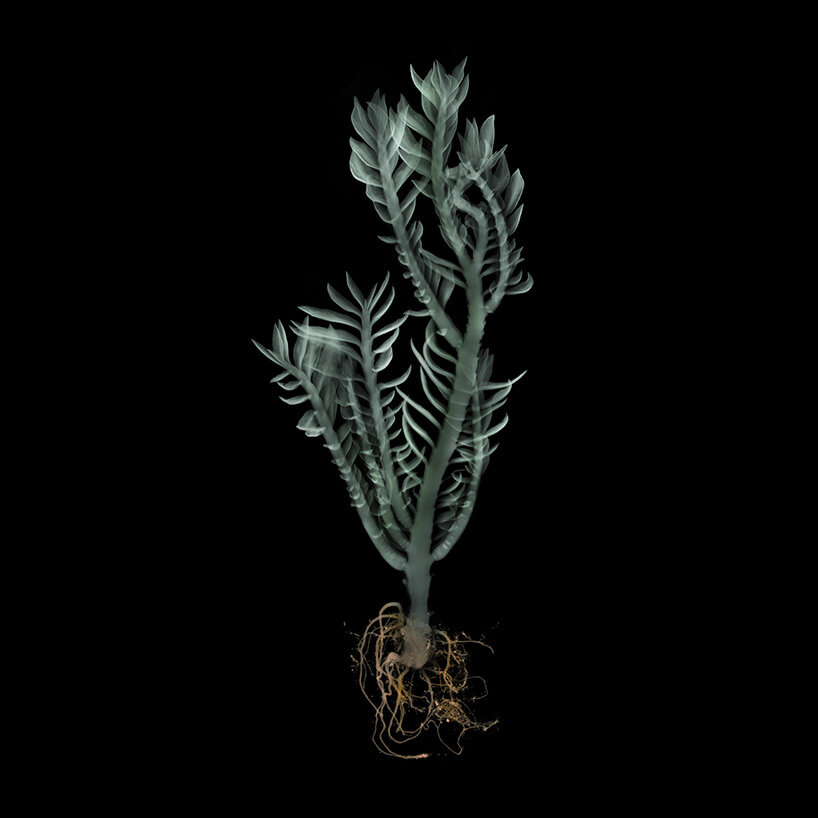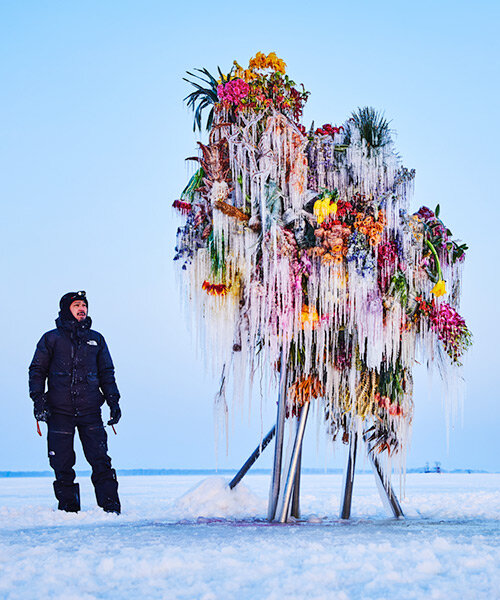azuma makoto has set flowers in ice, outer space, and underwater, visiting an abandoned power plant in belgium, a subterranean stone quarry in japan, and even the stratosphere. from the AMKK studio in tokyo, makoto and his team have produced countless experimental creations and exhibitions across the globe that have unearthed hidden aspects of flowers’ beauty from unparalleled perspectives. ‘the beauty of flowers passes through the boundaries of time periods, countries, languages and religions, and people instinctively feel the uniqueness of their beauty,’ makoto shares in an interview with designboom. ‘such beauty is so rare, it means flowers have universal beauty. the reason why people are fascinated by flowers is instinctual and is shared by humanity.’

frozen flowers, 2021 | read more about the ‘frozen flowers’ series on designboom here
often photographed in extreme states and scenarios, azuma makoto’s botanical artworks take command in any space they’re installed in, whether architectural or environmental. the poetic and powerful projects invite flowers into unknown territories and, in turn, encourage viewers to appreciate and consider the life of the natural world. recently, the artist began pursuing the ‘micro-world’ of flowers — their internal structure and inner world through X-ray and CT scans. ‘I would like to further explore new aspects of flowers like this and express their beauty by bringing out their charm,’ he shares.
designboom spoke with azuma makoto about finding a ‘friction’ for flowers in environments where they usually don’t exist, and how their beauty transcends language, region and time. readers can also find the interview in japanese at the bottom of the page.

frozen flowers, 2021
designboom (DB): what aspects of your background and upbringing have shaped your creative principles and philosophies?
azuma makoto (AM): I am not sure what aspects of my background and upbringing have influenced my creativity, but I was born, and grew up, in the countryside of fukuoka prefecture where nature was a very familiar existence to me. also, I was really influenced by music, especially punk music, which my brother was into when I was spending boring days — so I think devoting myself to music has had an influence on me mentally. I ‘scrap and build’, meaning once I create something, I destroy it. I keep questioning stereotypes and an existing sense of values, and constantly look for something new. by reflecting my inner thoughts, which I could not express in words into music, I educated my mentality and philosophy with nature and I think that has shaped the basis of my creativity.

X-ray flowers
DB: what draws you to flowers as an artistic medium, and what are their personal meaning to you?
AM: flowers start their lives from a bud, to bloom and eventually decay, and they show us different expressions at each moment, which fascinates us. by looking at each flower, just like human beings have individual differences, no flowers are perfectly identical. such ever-changing moments of flowers never bore me, and it always arose my spirit of inquiry for something unknown. also, from ancient times to the present age, flowers have been an everlasting motif for the cultural world — such as paintings, fashion and decorative art. they are creatures which are beautiful, fleeting, strong and give us energy to live in any period. culture always reflects the time, but people continue to use flowers as motives throughout the ages. I think that is because the beauty of flowers passes through the boundaries of time, countries, languages and religions, and people instinctively feel the uniqueness of their beauty. such beauty is so rare, that it means flowers have universal beauty. the reason why people are fascinated by flowers is instinctual, and is also shared by humanity.

X-ray flowers
DB: you have set flowers within ice, in outer space, and underwater — which of the landscapes you’ve worked in has fascinated you most?
AM: each project has its own fascinating landscape, so I do not choose one to be the best. I constantly seek to find what kind of ‘friction’ will be created by installing flowers in environments where flowers usually do not exist and discovering new unknown aspect of flowers’ beauty.

‘paludarium TACHIKO’ is a 19th-century terrarium reimagined for the modern era
read more on designboom here
DB: which project has been the most challenging to execute? what were the challenges?
AM: all projects, such as ‘shooting flowers into the stratosphere’ and ‘sinking flowers into the depths of the sea’, have their own challenges to execute, and there is never a project which I would be able to create easily. from the physical perspective, I had opportunities to create my artworks by bundling up different kinds of flowers at various locations. they have been fierce forests of the amazon, the salt lake in argentina with severe reflected heat which almost burned our eyes, snowfield in hokkaido in -15 degrees, and xishuangbanna in china which is located on top of a steep cliff. but in the first place, my mission is that I pick flowers and plants which are already beautiful enough to bloom in a natural field and bundle them to rearrange by myself to create new beauty. therefore, as I previously stated, there is no artwork which I could easily create physically and mentally. the lives of flowers and my life are constantly adjoining each other, and that is why I can put my soul into my artwork by uniting myself with flowers under such an extreme state.

in the middle of a snowfield in one of japan’s coldest geographical areas, azuma makoto set ‘shiki tou’ — an enormous pine carefully tethered to a huge steel framework by meticulously-tied rope cords and wire bond
read more on designboom here
DB: in a world that is increasingly virtual, your work is firmly rooted in tactile and physical experiences. do you think society today is moving too far away from traditional ways of making and craftsmanship?
AM: this question strikes me as very much to the point. the world is becoming increasingly virtual, and I think people’s five senses are exceedingly getting degenerated. however, at the same time, the values for traditional art and creation of the art, handwork by craftsman, and prominent techniques have increased and the time has become to be the one touches human’s hearts more. on the other hand, there is the fact that digitalization has become meaningful to human beings and our society, and that is the case for my artwork as well. I use flowers, and because of its characteristics, there is a limit to see them in person. however, with progress of digital technologies, it allows me to show my artwork to people who live on the other side of the world in real time, and a new world with unknown possibilities is in front of us, which we have never imagined before. therefore, I want to create my artworks with passion, which can be transmitted through an iPhone to viewers, and I believe any creations made by human’s hands have a soul in them. even if the shape of art and the way of expressions change in accordance with time, I do not think the value of things which are created by human beings would eventually ever become obsolete.
for ‘story of flowers 2’, azuma makoto’s original story was brought to life by the work of illustration and animation team, katie scott and james paulley. the film delves into the relationship between flowers and humans: the way we involve flowers in our lives through various cultures and practices.
DB: what do you hope audiences take away from your work? are there certain themes you hope your work provokes discussion about?
AM: I prefer for people to look at my artwork freely, whether they feel and take away something from my work or not. I run my own flower shop which has the specific style of taking made-to-order. I only buy the necessary number of flowers, and deliver my flower arrangements at an artistic level to the people in need. by operating this way, I could reduce flowers’ loss and be friendly to the global environment and flowers themselves. I have been continuing to do this sustainable method over the past twenty years. I hope audiences could feel this antithesis aspect of my artwork, but also believe that my flowers would tell the audience without putting it into words myself. moreover, I wish people with refined sensibilities to understand such aspects would increase.

within the vast and vacant inner expanse of the abandoned power plant IM in belgium, azuma makoto suspended the botanical installation ‘式1 × the abandoned power plant’ just above the space’s cavernous floor
read more on designboom here
DB: what are you currently fascinated by, and how is it feeding into your artistic practice?
AM: when I entered the flower’s world, there was the current of the times that many people tended to think flowers were beautiful when they bloomed, or flowers in full bloom was the best moment of admiring flowers. however, I did not think that was the only beauty of flowers, and have been pursing the expression of flowers’ lives — such as flowers’ roots — which we do not usually see and moments of beauty of right before they decay. and now, I feel this way of thinking has started expanding all over the world, and the era which more people start thinking about the global environment and the diversity of organisms has come. as a further step, I started concentrating my efforts on pursuing the micro-world of flowers, meaning the internal structure and inner world of flowers. its functionality goes without saying, but also its form and movement are always united with beauty. I would like to further explore new aspects of flowers like this and express their beauty by bringing out their charm.

from the series, ‘shiki: landscape and beyond’ | read more on designboom here
DB: can you tell us about any upcoming projects you are particularly excited about?
AM: I started pursuing new ways of expressing flowers’ beauty by applying methods such as X-ray and CT scans to pick out new aspects of flowers. I am planning on putting them together to novelize it, and am preparing to hold an exhibition, which is in progress. I hope people all over the world will look at them and feel the profound expression of a flower’s world.
designboom (DB): 東様の生い立ちや育ち方のどのような側面が、自身のクリエイティブの根本や哲学を形成していますか?
azuma makoto (AM): 自分自身の生い立ちのどういった側面が影響しているかは具体的には分からないが、福岡の片田舎に生まれ育ち、自然は常にごく身近な存在としてあり、退屈な日常の中で兄の影響で音楽、特にパンクロックに魅せられて音楽に傾倒したことは精神的に影響していると思う。「スクラップ・アンド・ビルド」すなわち生み出しては壊し、既成概念や価値観を疑い続け、常に新しさを求める。言葉にならない自分の内なる思いを音楽という形で表現する中で、そういうメンタリティや哲学を自然と培い、今の自分のクリエイティブの根幹になっていると思う。
DB: 花々を芸術的な媒体として捉えた時、その何が東様を惹きつけ、花々の個性は、東様に何を意味しますか?
AM: 花は蕾が芽吹いて花開き、やがて朽ちてゆくまでどの瞬間も違った表情でそれぞれの魅力がある。花一輪一輪を見ても、同じ種類でも人間と同じで個体差があり、一つとして同じものはない。そういった刻一刻と変化するさまが私を飽きさせず、常に未知なる探求心を掻き立てるのだと思う。また、古来から現代に至るまで、花は絵画、ファッション、装飾美術等 全ての文化の中においても永遠のモチーフであり、美しく、儚く、力強く、いつの時代も我々に生きるエネルギーを与えてくれる存在である。文化は常に時代を映し出すものでありながら、今も昔も変わることなくフラワーモチーフは使われ続けている。それは花が、時代や国、言葉や宗教を超えて人間が本能的に美しいと感じる数少ない美、普遍的な美であるということを意味していると言える。花に惹きつけられるのは人類共通の本能なのだと思う。
DB: 東様は今までに、花々を氷の中に入れたり、宇宙に打ち上げたり、海底に沈めたりされてきました。そのような作品の中で、今まででどの景色に一番魅力されましたか?
AM: どの作品でも魅力的な景色があり、どれか一番を選ぶことはしていない。花が本来生息していない環境に花をインストールすることでどのような「摩擦」が生まれ、花の新たな美を見出すことができるかを常に追い求めている。

makoto studies the ties between ‘flower and man’ | read more on designboom here
DB: 今までに行ったプロジェクトの中で、遂行するのに一番大変だったものはどれですか?またどのような事が大変だったのでしょうか?
AM: 成層圏へ花を飛ばすプロジェクトも、深海に花を沈めるプロジェクトも、それぞれに困難があり、決して楽に作品制作ができるものはひとつもない。物理的なことで言えば獰猛なアマゾンの森の中や、目を焼くような強烈な照り返しのアルゼンチンの塩湖、マイナス15℃の北海道の雪原、切り立つ崖の上の中国のシーサンパンナなど…実に様々な土地で様々な花を束ねて作品を作らせてもらった。ただ、そもそも私は野に咲く状態で十分美しい花や草木を切り、そして自らの手で束ね直して新しい美を生み出すことが使命なので、先に述べたように物理的にも精神的にも簡単に生み出せるような作品は一つもない。常に花の命と自分の命が隣り合わせの状態であり、そういった極限状態だからこそ、花と一体になり作品に魂が込められるのだと思う。
DB: バーチャル化が進む現世界において、東様の作品は触知でき、体感できることに根付いていると思います。
伝統的な方法で物を作ることや職人の技能を用いることから、現代は非常に離れたところに動いていっていると思われますか?
AM: まさに時代の核心をついた質問だと思う。バーチャル化が進み、実際に人の五感は限りなく退化していると思う。ただ同時に、伝統的な美術・芸術の創造や職人による手作業、卓越した技術というものの価値が高まり、より人の心を打つ時代でもある。デジタル化が一方で人や社会にとって有意義なものになっていることも事実であり、私の作品も、花という特性上直接目にする機会は限られても、デジタル技術の進歩で今はリアルタイムで地球の裏側の人も見ることができたり、今まででは考えられない世界が広がっている。だから私はスマホの画面の向こうの人にも伝わるような熱量で作品を作りたいと思うし、人の手で生み出されるものには魂が宿ると信じている。芸術の形、表現の方法は常に時代とともに変わっても、最終的には人が作るものそのものの価値が廃れていくということはないように思う。

experiments on decomposition at the ‘oi futuro’ museum in rio de janeiro, brazil | read more on designboom here
DB: 東様の作品を見た人々が、その作品から何を感じ取って欲しいと願いますか?自身の作品を通して人々が話し合うことを引き起こさせたい、何か特定のテーマはありますか?
AM: どのようなことを感じ取ってもらっても、感じ取れなくても、基本的に自由に見てもらえたらと思っている。ちなみに私は、自分で営んでいる花屋でもフルオーダーメイトのスタイルをとっているが、必要な分だけ花を仕入れ、必要としている人に芸術的なレベルの花束を届けることで、花のロスがなくなり地球環境にとっても花にとっても優しい、サステナブルな方法を20年以上前から継続している。そういったアンチテーゼ的な要素も感じてもらえたらと思うし、それは私のほうからあえて言葉にしなくても、花が語ってくれるものだと信じている。またそういったものを感じ取れる感性を持つ人が増えることを願っている。
DB: 今現在、東様自身が魅力されていることは何ですか?またそれは、どのように東様のアート作品に注ぎ込まれていますか?
AM: この世界に飛び込んだとき、多くの人は花は咲いているところが美しい、満開の花々が一番いいというような風潮があった。しかし私は花というものが決してそれだけではなく、普段見えない根の部分や枯れて朽ちてゆく寸前の瞬間美など、命としての花の姿を追求してきた。そして今、その考え方は世界中に広まり始めており、多くの人がより地球環境や生物の多様性について考える時代がきている。
私はさらに次のステージとして、今度はもっとミクロの世界、つまり花の内部構造、内面への探求に力を注いでいる。機能面はさることながら、そのフォルムや動きは常に美しさを併せ持っており、そういった花の新たな側面をもっと開拓し、さらに魅力を引き出して表現していきたいと考えている。
DB: 近々行われる、今特にワクワクしているプロジェクトの内容を教えていただけますか?
AM: 先述の通り、X-rayやCTスキャンといった新しい手法を用いて花の新たな側面を切り取るべく、表現を模索している。近々それを書籍化して発表し、展覧会を開く計画が進行しているが、世界中のより多くの人に見てもらい、花の世界の奥深さを感じてもらいたいと願っている。
























